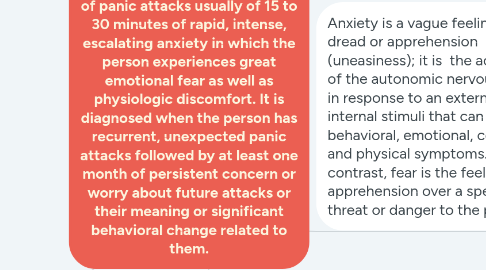Panic disorder/attacks is composed of discrete episodes of panic attacks usually of 15 to 30 minutes of rapid, intense, escalating anxiety in which the person experiences great emotional fear as well as physiologic discomfort. It is diagnosed when the person has recurrent, unexpected panic attacks followed by at least one month of persistent concern or worry about future attacks or their meaning or significant behavioral change related to them.
por Shayna Salvo


1. Deficient Knowledge The state in which an individual or group experiences a deficiency in cognitive knowledge or psychomotor skills concerning the condition or treatment plan.
1.1. May be related to Unfamiliarity with medications used and potential adverse effects.
1.2. Possibly evidenced by Verbalizes a deficiency in knowledge or skill or requests information. Expresses an inaccurate perception of health status. Does not corretly perform desired or prescribed health behavior.
1.3. Desired Outcomes Client states correct information about medications and adverse side effects.
2. Social Isolation: Aloneness experienced by the individual and perceived as imposed by others and as a negative or threatening state.
2.1. May be related to Maturational crisis. Panic level of anxiety. Past experiences of difficulty in interaction with others. Repressed fears.
2.2. Possibly evidenced by Uncommunicative Withdrawn No eye contact Insecurity in public Expression of feelings of rejection Preoccupation with own thoughts; repetitive meaningless actions
2.3. Desired Outcomes Client will willingly attend therapy activities accompanied by trusted support person. Client will voluntarily spend time with other clients and staff members in group activities.
3. Anxiety is a vague feeling of dread or apprehension (uneasiness); it is the activation of the autonomic nervous system in response to an external or internal stimuli that can have behavioral, emotional, cognitive, and physical symptoms. In contrast, fear is the feeling of apprehension over a specific threat or danger to the person
3.1. Fear: Response to perceived threat that is consciously recognized as a danger
3.2. Possibly evidenced by Acknowledge and discuss fears. Demonstrate understanding through use of effective coping behaviors and active participation in treatment regimen. Resume normal life activities.
3.3. Desired Outcomes Client will be able to discuss phobic object or situation with the nurse. Client will be able to function in presence of phobic object or situation without experiencing panic anxiety by time of discharge from treatment.
4. Anxiety disorders comprise a group of conditions that share a key feature of excessive anxiety with ensuing behavioral, emotional, cognitive, and physiologic responses. People suffering from anxiety disorders can demonstrate unusual behaviors such as panic without reason, unwarranted fear of objects, or unexplainable or unwavering worry. They experience significant distress over time, and the disorder significantly impairs their daily routines, social lives, and occupational functioning.
4.1. Ineffective Coping: Inability to form a valid appraisal of the stressors, inadequate choices of practiced responses, and/or inability to use available resources.
4.1.1. May be related to: Situational crises Maturational crises Fear of failure
4.1.2. Desired Outcomes Client will decrease participation in ritualistic behavior. Client will demonstrate ability to cope effectively. Client will verbalize signs and symptoms of increasing anxiety and intervene to maintain anxiety at manageable level. Client will demonstrate ability to interrupt obsessive thoughts and refrain from ritualistic behaviors.
4.1.3. Possibly evidenced by Ritualistic behavior or obsessive thoughts Inability to meet basic needs Inability to meet role expectations Inadequate problem solving

